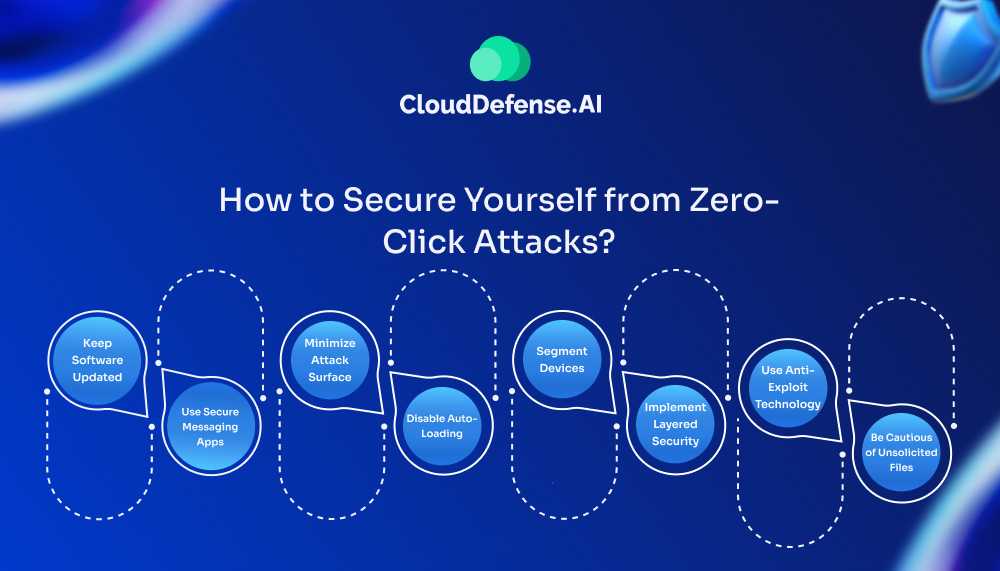What is a Zero Click Attack?
Imagine this: you’re scrolling through social media, reading emails, or simply using your phone as usual. Suddenly, your device is compromised, with sensitive data stolen or malicious software installed. But here’s the twist: you never clicked on a single link, downloaded a file, or interacted with anything suspicious. That’s the unsettling reality of a zero click attack.
These attacks exploit vulnerabilities in commonly used apps and operating systems to gain unauthorized access and deliver malware payloads. And, all it takes is receiving a seemingly innocent message, email, or multimedia file embedded with malicious code. Once received, the malware executes automatically, circumventing security measures and granting attackers complete control over the compromised device.
The “zero-click” aspect of these attacks is what makes them particularly insidious. Users have no way to identify or prevent the attack vector, as the exploit occurs invisibly behind the scenes. This elevates the threat level significantly, as even tech-savvy individuals can fall victim without any apparent missteps on their part.
How Does a Zero Click Attack Work?
Here’s a short scenario illustrating how a Zero Click Attack works: You receive a video message from a friend on WhatsApp. Unaware that the video contains malicious code, you let it load automatically. In the background, the code exploits a vulnerability in WhatsApp to inject malware onto your phone.
Without any further action from you, the malware obtains full administrative privileges. It now has free rein to monitor your communications, activate your camera/microphone remotely, log your keystrokes, and exfiltrate sensitive data. You continue using your device normally, oblivious that it has already been compromised by the Zero Click Attack.
The malware operates silently, requiring no clicks or downloads on your part to carry out its nefarious activities. Weeks later, you may start noticing performance issues or unauthorized access attempts – the first signs that your device has been subtly subverted through a single innocuous video message.
Examples of Zero Click Attacks in the Wild
Apple: In 2021, a sophisticated zero-click exploit dubbed “ForcedEntry” targeted iPhones. This attack leveraged a vulnerability in Apple’s iMessage to deploy Pegasus spyware, giving attackers access to a user’s device without any user interaction. The attack specifically targeted activists and journalists, highlighting the potential for zero click attacks in espionage.
WhatsApp: WhatsApp has been the target of multiple zero-click exploits that allowed the installation of Pegasus spyware developed by NSO Group. In 2019, attackers used a buffer overflow vulnerability to inject malware simply by calling the target device. A similar flaw was discovered in 2020 that enabled remote code execution from a malicious GIF.
The Case of Jeff Bezos: In a high-profile incident, attackers compromised Amazon CEO Jeff Bezos’ phone in 2018 through a seemingly innocuous video message sent via WhatsApp. Once Bezos’ phone processed the video, the exploit code was triggered, compromising his device. This incident serves as a reminder that even the most powerful people are not immune to zero click attacks.
Why are Zero click attacks difficult to defend against?

Zero click attacks are notoriously difficult to defend against for a few key reasons:
No User Interaction Required — The biggest challenge is that zero-click exploits require absolutely no user interaction to initiate. Traditional attacks rely on tricking the user into opening a malicious link or file. With zero-click, the malware executes invisibly without any actions from the victim.
Hard to Detect — Since there’s no need for a user to enable the attack, zero-click exploits can silently compromise devices without raising red flags. Malicious payloads execute under the radar, hidden from conventional security monitoring.
Vulnerabilities Are Constantly Evolving — Attackers are continuously uncovering new vulnerabilities in operating systems, apps, and communication protocols. As software evolves, so do the attack surfaces. Defending against a steady stream of zero-day flaws is enormously challenging.
Remote Exploitation — Many zero click attacks can be triggered remotely across messaging apps, WiFi, or cellular networks. This remote vector exposes billions of devices anywhere to potential compromise with little opportunity for mitigation.
Widespread Vulnerable Software — The same highly popular apps and OSes that enable modern digital life also provide a massively scalable attack surface when flaws exist within their codebases.
How to Secure Yourself from Zero Click Attacks?

The insidious nature of zero click attacks – requiring no user intervention – makes them particularly difficult to defend against. However, there are some steps you can take to reduce your risk exposure:
Keep Software Updated — One of the most effective defenses is to keep your operating system, apps, and software libraries updated with the latest security patches. Many zero-click exploits target known vulnerabilities, so applying patches promptly closes those attack vectors.
Use Secure Messaging Apps — Opt for messaging apps like Signal that prioritize encryption and security. Undergo regular security audits to find and fix zero-click flaws. Don’t blindly trust any app to be impervious.
Minimize Attack Surface — Delete applications you no longer use. Unused apps can harbor vulnerabilities and create potential entry points for attackers.
Disable Auto-Loading — If possible, disable automatic loading or previewing of media attachments from untrusted sources. This forces messages to be manually opened, reducing surprise attack opportunities.
Segment Devices — Don’t intermingle devices used for sensitive work and personal communications. Compartmentalize to limit widespread compromise.
Implement Layered Security — Explore installing reputable security software that can offer additional protection against malware and exploits. While not foolproof, security software can help detect and block suspicious activity.
Use Anti-Exploit Technology — Deploy security solutions that can detect and mitigate zero-click exploitation techniques through behavior monitoring and other methods.
Be Cautious of Unsolicited Files — Maintain healthy suspicion of unsolicited video, audio or document files from untrusted senders, even if they appear to come from known contacts.
Final Words
At the end of the day, zero-click exploits are scary precisely because one single click might be all it takes — but you might not even click it. But implementing these defensive habits that we discussed above makes life way harder for the malicious actors. Staying proactively skeptical and security-minded isn’t just smart…it’s surviving in our digitally unsafe world. The digital battlefield is upon us. Are we prepared?







